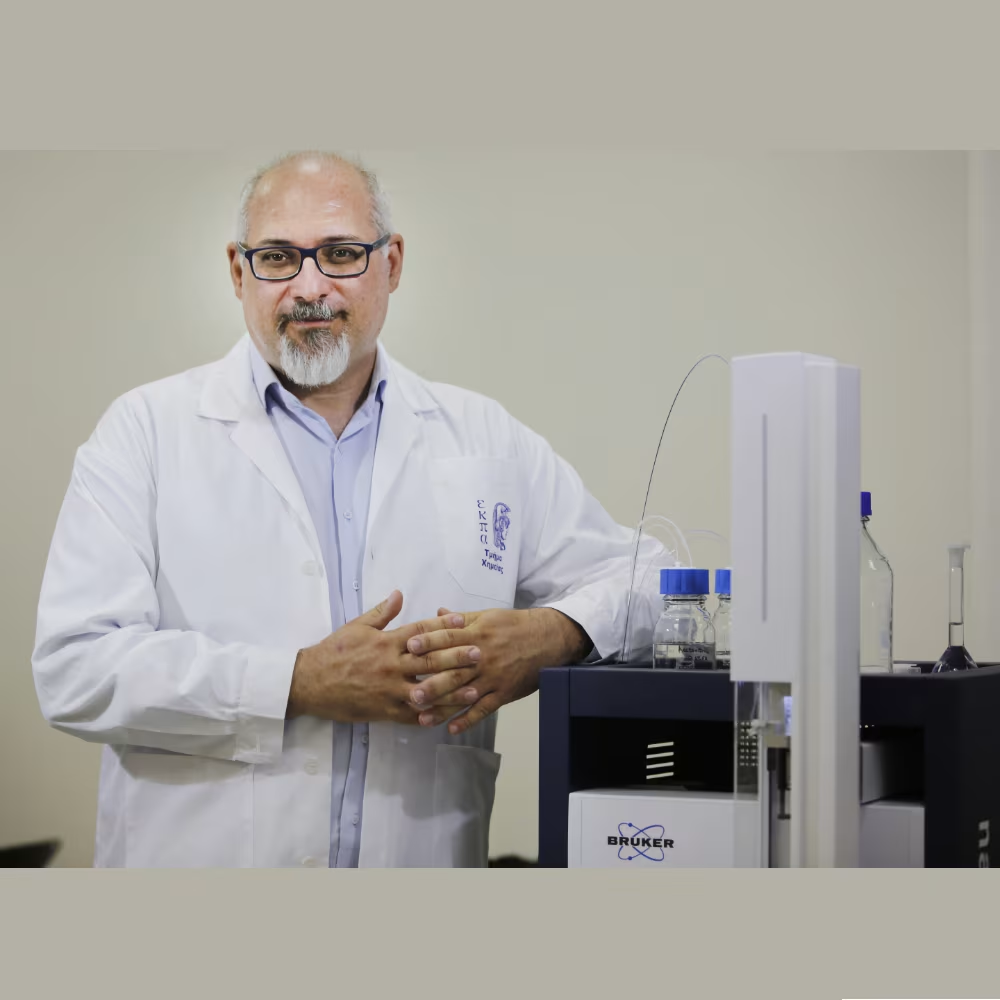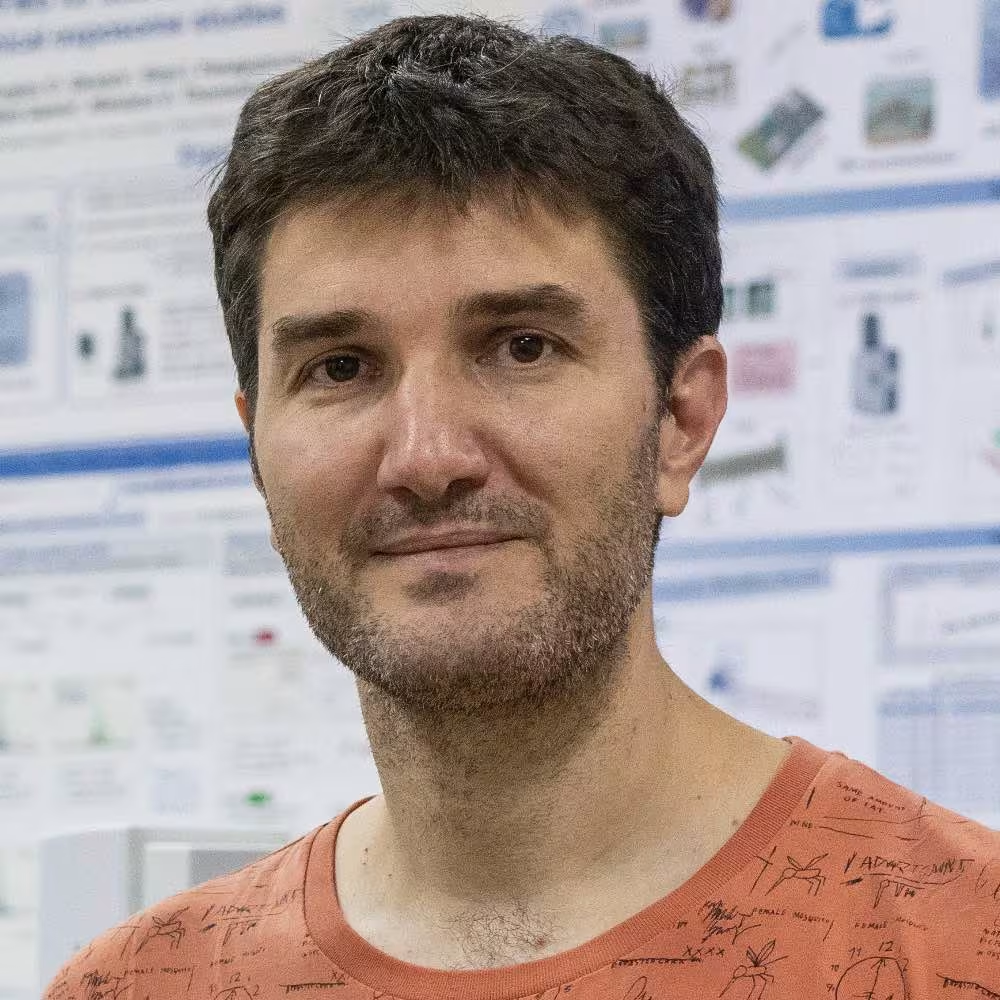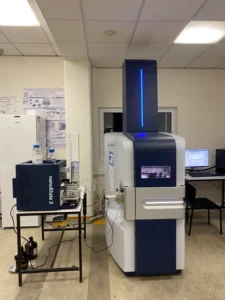Mass Spectrometry
The Mass Spectrometry Unit (MSU) of the School of Science Core Facility at the National and Kapodistrian University of Athens is a central hub for advanced chemical analysis and molecular characterization. Its mission is to serve the research community of the University and external collaborators, providing access to state-of-the-art instrumentation and expert guidance in the study of biomolecules, clinical specimens, food and environmental samples, and a wide range of natural and synthetic compounds.
The MSU integrates high-resolution mass spectrometry platforms with versatile ionization sources and advanced computational workflows, enabling investigations at multiple levels of complexity. Applications extend across proteomics, lipidomics, and metabolomics, as well as elemental analysis (ICP-MS), supporting both targeted studies and large-scale screening approaches. This broad scope allows for comprehensive sample profiling and characterization, addressing questions that span from molecular mechanisms to population-level exposures.
In addition to providing analytical services, the unit actively supports collaborative research, encouraging joint publications, proposal development, and participation in both national and international projects. Research activities focus on developing innovative workflows for targeted, suspect, and non-targeted screening; building digital libraries and repositories of clinical, food, and environmental samples for regulatory and scientific use; and advancing computational models for compound identification, annotation and semi-quantification. Special emphasis is placed on the detection of emerging contaminants, bioactive molecules, transformation products, and trace elements, offering new insights into biological, environmental, and industrial processes.
The MSU also contributes to scientific education by offering specialized training in modern MS technologies, data processing strategies, and in-silico prediction tools. By combining expertise, cutting-edge instrumentation, and a collaborative approach, the unit establishes itself as a dynamic environment where analytical science, innovation, and interdisciplinary research converge to address contemporary challenges in chemistry, biology, clinical research, food science, and environmental studies.
Staff
Head of Unit

Professor Nikolaos Thomaidis
Head of Mass Spectrometry Unit
Principal Investigator

Assistant Professor Marios Kostakis
LC-MS/MS & ICP/MS Sub Units
Principal Investigator

Dr. Guillaume Medard
Proteomics Sub Unit
Principal Investigator

Dr. Julie Courraud
Proteomics Sub Unit
Principal Investigator

Dr.Ioannis Martakos
Lipidomics and Metabolomics Sub Units
ICP
SERVICES
The Inductively Coupled Plasma – Mass Spectrometry (ICP-MS) Unit of the Core Facility of the National and Kapodistrian University of Athens is part of the horizontal infrastructure of the School of Sciences. The purpose of the instrumentation is to determine multi-element contents in a wide range of samples and scientific fields such as food samples, environmental matrices (water, soil, etc.), biological fluids (blood, urine), geological samples at ppb concentration levels. The instrument uses a collision/reaction cell to avoid polyatomic interferences and is equipped with two collision/reaction gas options, helium and hydrogen. An autosampler is included in the system and, in addition, the Integrated Sample Introduction System (ISIS) shortens the analysis run and reduces the consumption of argon gas. The system is also suitable for rare earth analysis at ppt levels. Another feature of the instrument is the High-Matrix Introduction System, which helps to analyse the most challenging matrices, such as seawater samples, without time-consuming pre-treatment.
- Supports the determination of virtually all elements of the periodic table in environmental samples, food samples and biological fluids.
- Ideal for analysis in chemistry, geology and environmental sciences.
- Some of the most useful applications include Determination of lead, cadmium, mercury, chromium and nickel in water/food/biological fluids.
- Determination of all regulated elements in water according to EU and national regulations.
- Determination of rare earth elements as part of authenticity studies.
TECHNOLOGY AND EQUIPMENT
Agilent 7900 ICP-MS System
- Acquisition modes: No Gas, Helium, Hydrogen
- Mass ranges from 2–260
- Mass resolution of < 1.0u (from 0.3u)
- The dynamic range > 11 orders
- High Matrix Introduction (HMI)
- Plasma tolerates total dissolved solids (TDS)
- Levels greater than the 0.1 to 0.2%
- HMI dilutes the sample aerosol using clean, dry argon gas.

Agilent 7900
LC-MS/MS
SERVICES
The Liquid Chromatography-Tandem Mass Spectrometry (LC-MS/MS) Unit of the Core Facility of the National and Kapodistrian University of Athens is part of the horizontal infrastructure of the School of Sciences. The purpose of the instrumentation is to determine organic compounds in a wide range of matrices and scientific fields such as metabolites, environmental contaminants, and general compounds of interest with a well-defined selectivity and at sub-ppb concentration levels.
- Supports the determination of chemical organic compounds in environmental matrices, foods, pharmaceutical formulations, and biological fluids extracts.
- PFAS
- Mycotoxins
- Metabolites
- pharmaceuticals
- environmental contaminant
- veterinary residues,
- Ideal for Chemistry and Life Sciences targeted analysis, covering small molecule determination, quantitative analysis with high selectivity criteria, pharmaceutical analysis, environmental and food analysis.
TECHNOLOGY AND EQUIPMENT
AB SCIEX QTRAP 6500+ System
The most common feature of this instrument, which provides the above benefits, is the Multiply Reaction Monitoring (MRM) scan mode, a function that is performed by all triple stage quadrupole mass spectrometers.
Τhe system can operate in linear trap mode to improve selectivity for difficult matrices (biological fluids, food matrices, etc.) and to avoid the most difficult interferences between samples. Furthermore, it can operate in dual ionization mode (positive and negative ionization switching) and the ion source is equipped with heating Electrospray Ionization (ESI) and Atmospheric Pressure Chemical Ionization (APCI). The system is equipped with ultra-pressure liquid chromatography, which increases the peak resolution between chemical compounds and reduces the analysis time.
- Liquid Chromatography System– ExionLC AD series with a 109-position autosampler (4°C to 35°C), 0.1–50 µL injection volume, 1300 bar max pressure, and column oven up to 90°C. Binary pump included.
- Mass Spectrometer– Triple quadrupole (5–2000 Da) and linear ion trap (50–2000 Da) with ESI/APCI ionization (600°C). Fast polarity switching (5 ms).

AB SCIEX QTRAP 6500+
Lipidomics
SERVICES
The Lipidomics Unit of the Core Facility at the National and Kapodistrian University of Athens is a specialized unit dedicated to the in-depth analysis of lipid species across various biological systems. This facility is designed to support academic researchers, industrial partners, and healthcare professionals in understanding lipid metabolism, biomarker discovery, and the role of lipids in health and disease. Utilizing state-of-the-art instrumentation, the facility offers comprehensive lipid profiling, structural characterization, and quantification of lipid species from diverse sample types.
TECHNOLOGY AND EQUIPMENT
TIMS-TOF-Pro 2
- Features Trapped Ion Mobility Spectrometry (TIMS) for high-resolution separation of lipid isomers.
- Provides ultra-high sensitivity and specificity for lipid identification and semi-quantification.
- Capable of high-throughput lipidomic workflows with fast duty cycles.
- Ideal for the characterization of complex lipid mixtures in biological samples.
TIMS-TOF-FLEX
- Equipped with MALDI (Matrix-Assisted Laser Desorption/Ionization) capabilities for spatial lipidomics.
- Allows for direct tissue analysis and mapping of lipid distributions in biological specimens.
- Combines ion mobility separation with high-resolution mass spectrometry for superior lipid characterization.
- Supports both targeted and untargeted lipidomics approaches.
Metabolomics
SERVICES
Metabolomics is the scientific study of the metabolome—the complete set of metabolites and their interactions within a biological system. Organisms are actually complex super-organisms. Their phenotype is determined by their own DNA expression, the coexistence of various biological entities (e.g. microbiome) and by the exposure to different environmental conditions. Metabolomics provides the snapshot of an organism’s current phenotype.
By bridging the gap between genetic background, gene expression, and environment stimuli (i.e., lifestyle, diet, exposure, and microbiota), metabolomics plays a crucial role in understanding underlying biological processes. It complements other omics technologies (genomics, transcriptomics, and proteomics), enabling a holistic interpretation of different phenotypes. Metabolomics has broad applications in health, life sciences, food and nutrition, environmental research, toxicology, and beyond.
At the core facility of the National and Kapodistrian University of Athens, researchers have access to state-of-the-art instrumentation that facilitates hight throughput, high-accuracy, sensitivity, and specificity analyses.
- Sample preparation (clinical, biological, food, environmental samples, etc.)
- LC-MS based chemical analysis (DIA, DDA, PASEF, MRM, PRM)
- Statistical analysis: variable selection, univariate & multivariate analysis, machine learning, etc.
- Identification: metabolites annotation (library based, de novo, in silico, GNPS, mass defect filters, ontology based etc.)
- Interpretation: pathway analysis, enrichment analysis, biological assessment
TECHNOLOGY AND EQUIPMENT
Bruker TimsTOFpro2 equipped with the Apollo ESI or HESI source coupled to Elute UPLC pump
- SCIEX Triple Quad 5500+ couple to ESI/APCI and UPLC pump
- SCIEX Triple Quad 6500+ (Q-Trap) couple to ESI/APCI and UPLC pump

Bruker TimsTOFpro2
Proteomics
SERVICES
Diagnostics
- Supports protein-typing of laser capture microdissected amyloid deposits from fat aspirate, kidney, heart, salivary gland (and more) FFPE biopsies.
- Requests will be transferred to the Referral Center for Amyloidosis at Alexandra hospital, Athens (Prof. Kastritis) for approval in the context of the patient’s clinical picture. We also encourage requests for amyloid typing for external validation studies and research projects.
Full proteomes
- Supports differential proteomics experiments within a cohort of samples.
- Ideal for Health Sciences and Life Sciences, covering model systems and patient cohorts such as cell pellets (cell lines, CD138+, bacteria and other), tissues (mammalian (liver, muscle, brain), and other species (plant seeds)), but not plasma/serum.
Chemoproteomics
- Supports the identification of proteins bound by small molecules (target deconvolution and selectivity profiling) in relevant, user-chosen biological systems.
- Ideal for Medicinal/Pharmaceutical Chemistry and Life Sciences, covering profiling of novel drug candidate, drug repurposing, mode-of-action elucidation.
TECHNOLOGY AND EQUIPMENT
Bruker timsTOF fleX - nanoElute 2
- This system features a nanoElute 2 liquid chromatography system dedicated to nanoflow elution of the analytes.
- The system is equipped with a tims (Trapped Ion Mobility Spectrometry) tunnel, allowing for separation by ion-mobility as a 4th dimension.
- System allows for PASEF (Parallel Accumulation Serial Fragmentation) technology, including data-dependent acquisition (DDA) and data-independent acquisition (DIA), and notably library-free diaPASEF.
- Data processing is performed on latest generation software (FragPipe, DIA-NN), using neural-network-predicted peptide spectra.

Bruker timsTOF fleX - nanoElute 2
mass spectrometry Unit Publications
- Panara, A.; Biliraki, D.; Nussbaumer, M.; Filiou, M. D.; Thomaidis, N. S.; Kostakis, I. K.; Gikas, E., Liquid Chromatography-Tandem Mass Spectrometry Method Development and Validation for the Determination of a New Mitochondrial Antioxidant in Mouse Liver
- Panara, A.; Gikas, E.; Tzavellas, I.; Thomaidis, N. S., Comprehensive HRMS Chemical Characterization of Pomegranate-Based Antioxidant Drinks via a Newly Developed Suspect and Target Screening Workflow. Molecules 2023, 28, (13),
- Panara, A.; Gikas, E.; Thomaidis, N. S., Complete Chemical Characterization of Crocus Sativus via LC-HRMS: Does Trimming Affect the Chemical Content of Saffron? Food Chemistry 2023,
- Panara, A.; Gikas, E.; Koupa, A.; Thomaidis, N. S., Longitudinal Plant Health Monitoring via High-Resolution Mass Spectrometry Screening Workflows: Application to a Fertilizer Mediated Tomato Growth Experiment. Molecules 2023, 28, (19),
- Mastoras, P.; Zkeri, E.; Panara, A.; Dasenaki, M. E.; Maragou, N. C.; Vakalis, S.; Fountoulakis, M. S.; Thomaidis, N. S.; Stasinakis, A. S., Application of a pilot-scale solar still for wine lees management: characterization of by-products and valorizatio
- Panara, A.; Katsa, M.; Kostakis, M.; Bizani, E.; Thomaidis, N. S., Monitoring of Aflatoxin M1 in Various Origins Greek Milk Samples Using Liquid Chromatography Tandem Mass Spectrometry. Separations 2022, 9, (3),
- Panara, A.; Gikas, E.; Thomaidis, N. S., From By-Products to Fertilizer: Chemical Characterization Using UPLC-QToF-MS via Suspect and Non-Target Screening Strategies. Molecules 2022, 27, (11),
- Panara, A.; Aalizadeh, R.; Thomaidis, N. S., Chemical characterisation of Pelargonium sidoides root based on LC-QToF-MS non-target screening strategies. Phytochemical analysis : PCA 2022, 33, (1), 40-56
- Oikonomopoulos, P.; Pagkali, V.; Kritikou, E.; Panara, A.; Kostakis, M. G.; Thomaidis, N. S.; Tziotzi, T. G.; Economou, A.; Kokkinos, C.; Papaefstathiou, G. S., Oxalamide Based Fe(II)-MOFs as Potential Electrode Modifiers for Glucose Detection. Chemistry
- Meklati, F. R.; Panara, A.; Hadef, A.; Meribai, A.; Ben-Mahdi, M. H.; Dasenaki, M. E.; Thomaidis, N. S., Comparative Assessment of Antibiotic Residues Using Liquid Chromatography Coupled with Tandem Mass Spectrometry (LC-MS/MS) and a Rapid Screening Test
- Iliopoulou, A.; Zkeri, E.; Panara, A.; Dasenaki, M.; Fountoulakis, M. S.; Thomaidis, N. S.; Stasinakis, A. S., Treatment of different dairy wastewater with Chlorella sorokiniana : removal of pollutants and biomass characterization. Journal of Chemical Tec
- Aalizadeh, R.; Panara, A.; Thomaidis, N. S., Development and Application of a Novel Semi-quantification Approach in LC-QToF-MS Analysis of Natural Products. Journal of the American Society for Mass Spectrometry 2021, 32, (6), 1412-1423
- Siopi, M.; Rivero-Menendez, O.; Gkotsis, G.; Panara, A.; Thomaidis, N. S.; Alastruey-Izquierdo, A.; Pournaras, S.; Meletiadis, J., Nationwide surveillance of azole-resistant Aspergillus fumigatus environmental isolates in Greece: detection of pan-azole re
metabolomics sub-unit publications
- Barla I., Papagiannopoulou E., Antoniadi K., Polychronopoulou S., Thomaidis N., Gikas E., Untargeted metabolomics reveal the biochemistry of chemotherapy-induced cardiotoxicity risk in a pediatric cohort of patients. Talanta. 2025;292(February):127865. do
- Theocharaki K., Anastasiadi A., Delicou S., et al., Cellular and biochemical heterogeneity contributes to the phenotypic diversity of transfusion-dependent beta thalassemia. Blood Adv. February 2025.
- Barla I., Dagla I., Daskalopoulou A., Panagiotopoulou M. et al., Metabolomics highlights biochemical perturbations occurring in the kidney and liver of mice administered a human dose of colistin. 2024;(July):1-17.
- Mpakali A., Barla I., Lu L., et al. Mechanisms of Allosteric Inhibition of Insulin-Regulated Aminopeptidase. J Mol Biol. 2024;436(6):168449.
- Barla I., Efentakis P., Lamprou S., et al. Metabolomics Point out the Effects of Carfilzomib on Aromatic Amino Acid Biosynthesis and Degradation. Int J Mol Sci. 2023;24(18).
- Barla I., Efentakis P., Lamprou S., et al. An Untargeted Metabolomics Approach on Carfilzomib-Induced Nephrotoxicity. Molecules. 2022;27(22).
- Efentakis P., Lamprou S., Makridakis M., et al., Mineralocorticoid receptor signaling is implicated in carfilzomib-induced increase in blood pressure. Eur Heart J. 2021;42(Supplement_1):ehab724.3416.
- Efentakis P., Lamprou S., Makridakis M., et al., Mineralocorticoid Receptor Pathway Is a Key Mediator of Carfilzomib-induced Nephrotoxicity : Preventive Role of Eplerenone. Hemasphere. 2022. doi:10.1097/HS9.0000000000000791
proteomics sub-unit publications
- Choustoulaki A., Kostopoulos I. V., et al., Impact of empagliflozin on immune cells mediates protection against ischemic heart failure in mice. 2026.
- Karousi P., Voumvouraki M., et al., Easy Proteomics Sample Preparation: Technical Repeatability and Application Across 8 Biological Matrices in a New Core Facility Setting. PROTEOMICS. 2025. doi:10.1002/pmic.70064
- Courraud J., Nikolaou P. E., et al., Amyloidosis: how proteomics can make a difference in clinical practice. 2024.
- Karousi P., Voumvouraki M., et al., The privilege of a new core facility: Optimising technical repeatability and workflow efficiency in proteomics across diverse biological matrices.2024. doi:10.22541/au.174249556.68892754/v1
- Theologi O., Kollias I., et al., Integrated Transcriptomic and Proteomic Analysis of Clonal Plasma Cells From Patients With AL Amyloidosis.2025.
- Sánchez B. G., Mora-Rodríguez J. M., et al., TRPV1 Downregulation Impairs Prostate Cancer Growth: Functional and Translational Insights from Cellular and In Vivo Models. Experimental & Clinical Cancer Research (Under Revision). 2025.
- Voumvouraki M., Nikolaou P. E., et al., Presenting a practical lysis protocol with trifluoroacetic acid for proteomic analysis in amyloid diagnostics.2025.
- Karousi P., Voumvouraki M., et al., Streamlining Proteomics Workflows at a New Core Facility: Enhancing Repeatability and Efficiency Across Biological Matrices.2025.
- Médard G., Adding the proteome-dimension to medicinal chemistry.2025.
- Gkalea V., Nikolaou P. E., et al., On a quest for fingerprints of crystalglobulinemia on platelets and endothelium. Blood (Under Review). 2025.
- Médard G., Sheltzer J. M., et al., Ricolinostat is not a highly selective HDAC6 inhibitor. Nature Cancer. 2023. doi:10.1038/s43018-023-00582-3
- Theodorakakou F., Fotiou D., et al., Re-evaluation of Mayo 2004 and revised Mayo 2012 staging in patients with AL amyloidosis in the era of new therapies. Amyloid. 2025. doi:10.1080/13506129.2025.2456790
- Médard G., Chemoproteomics (Histone deacetylases). 2024.
- Courraud J., Setting up a Proteomics Core Facility in Athens: challenges and opportunities. Focus on amyloidosis, multiple myeloma and cancer.2025.
- Courraud J., New advances in clinical proteomics in Athens: from diagnostics in amyloidosis to research in multiple myeloma.2025.
- Tzanai A., Sánchez B. G., et al., Establishing Dried Matrix Spot Proteomics for Discovery in Murine Tissue.2025.
- Tsiounis N., Choustoulaki A., et al., Deciphering the off-targets of sodium glucose co-transporter inhibitors to provide insights to their cardioprotective mechanism.2025.
- Courraud J., Médard G., et al., Evaluation of a protocol for proteomics analysis of biological samples using the organic phase remaining after nucleic acid isolation.2023.
- Gakiopoulou H., Courraud J., et al., C5b9 and other complement proteins are enriched in the glomerulus: evidence from immunohistochemistry, immunofluorescence and mass spectrometry. Virchows Archiv. 2024. doi:10.1007/s00428-024-03880-y
- Courraud J., Barla I., et al., Dual metabolomics–proteomics extraction of murine bone marrow-isolated cells.2025.
- Karousi P., Kollias I., et al., Technical repeatability and efficiency in proteomics: a comparative study of various biological matrices.2024.
- Courraud J., Nikolaou P. E., et al., Setting up proteomic typing from scratch in Greece: challenges and opportunities. 2024. doi:10.1080/13506129.2024.2347124
- Voumvouraki M., Nikolaou P. E., et al., Diagnostic application of proteomics: testing a new sample preparation for the typing of amyloid proteins in biopsies.2024.
lipidomics sub-unit publications
Book our Equipment
We look forward to supporting your research with the best tools and expertise available. Explore our resources and unlock new possibilities at NKUA Core Facilities today!
You can use your NKUA account to book our equipment quickly and easily by clicking the button below.
If you are an external user, please use the appropriate booking form.
Availability
External Users
Book our Equipment
We look forward to supporting your research with the best tools and expertise available. Explore our resources and unlock new possibilities at NKUA Core Facilities today!
You can use your NKUA account to book our equipment quickly and easily by clicking the button below.
If you are an external user, please use the appropriate booking form.
Availability
External Users
Book our Equipment
We look forward to supporting your research with the best tools and expertise available. Explore our resources and unlock new possibilities at NKUA Core Facilities today!
You can use your NKUA account to book our equipment quickly and easily by clicking the button below.
If you are an external user, please use the appropriate booking form.
Availability
External Users
Book our Equipment
We look forward to supporting your research with the best tools and expertise available. Explore our resources and unlock new possibilities at NKUA Core Facilities today!
You can use your NKUA account to book our equipment quickly and easily by clicking the button below.
If you are an external user, please use the appropriate booking form.
Availability
External Users
Book our Equipment
We look forward to supporting your research with the best tools and expertise available. Explore our resources and unlock new possibilities at NKUA Core Facilities today!
You can use your NKUA account to book our equipment quickly and easily by clicking the button below.
If you are an external user, please use the appropriate booking form.